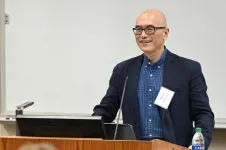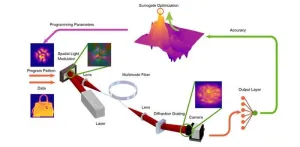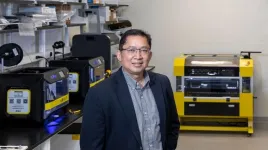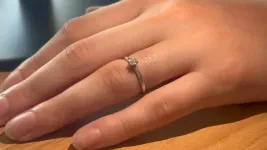(Press-News.org) SAN ANTONIO, Jan. 25, 2024 — It is a far cry from the traditionally thought-of “vegetative state” in which the mind is absent while the body lives on. Indeed, it is the opposite. Children with “locked-in syndrome,” unable to move or speak, are awake and fully aware of their surroundings.
Researchers from The University of Texas Health Science Center at San Antonio (UT Health San Antonio) were the first to report in peer-reviewed medical literature that, after non-fatal drownings, children would be locked in. The team, directed by Peter T. Fox, MD, professor of radiology and neurology and director of UT Health San Antonio’s Research Imaging Institute, described a set of features in brain imaging studies that identified the cause and explanation of locked-in syndrome.
The first 11 pediatric drowning survivors were imaged at UT Health San Antonio in the 2010s. Now, in follow-up research published in the journal Pediatric Neurology, the team reports the largest study to date on the subject. The recently published analysis of 154 children confirms that the predominant outcome of non-fatal pediatric drowning is locked-in syndrome.
In the research, 60% of children who survived drowning events (93 of 154) were classified as locked in by family caregivers surveyed by UT Health San Antonio.
“The range of disability in the children was large,” Fox said. “About one-fourth were mildly impaired, very nearly normal in all functions. Half were moderately impaired motorically but with preserved cognition and perception. One-fourth were severely impaired motorically, but less spared cognitively. Of the moderate and severe groups, nearly 80% were locked-in.”
Caregivers in tune with the children
Caregivers were identified and surveyed between 2018 and 2021 after Fox and colleagues published the initial brain imaging studies of pediatric non-fatal drowning in 2016 and 2017. Fox said the data obtained from the survey was clear and powerful.
“The take-home from this is that the parents and other caregivers of locked-in children really understand the cues they see and do an exceptional job sensing whether the children are responding or not responding,” Fox said.
“Physicians and the health care team should find more ways to engage the parents and caregivers and trust their observations,” he said. “Caregivers are a very underutilized resource. We need to be more respectful and aware of the quality of their observations.”
Remembering Conrad
The first child survivor to be imaged at UT Health San Antonio was Conrad Tullis of San Antonio.
Conrad, born in 2002, survived drowning in 2004 and lived to be 20. He inspired many and attended all 12 grades of school, graduating in the Alamo Heights School District in San Antonio.
“The locked-in state of Conrad and the other children was recognized first by the parents, which is very important to note,” Fox said. “This condition was brought to my attention by Liz Tullis, Conrad’s mom, who noticed her son was responsive even though she was being told he could not understand her. Tullis, along with other parents from a support group for parents of children who survived a drowning, helped the team recruit for the studies.
“As parents, we know our children, and we can tell the difference between responsive and unresponsive,” Tullis said. “While doctors were telling me my child would never lead a meaningful life, I knew he was capable of understanding and communicating with us, albeit he was non-verbal.”
Imaging gleans answers
The parents had read news stories about the Research Imaging Institute, a highly specialized center at UT Health San Antonio that brings multiple imaging modalities (magnetic resonance imaging, functional MRI, positron emission tomography and more) to bear on research questions. “They came to ask if imaging could tell whether the doctors were right in telling them that the children were not conscious, or whether they, the caregivers, were right,” Fox said.
The Research Imaging Institute’s imaging studies revealed that cognitive and sensory networks are preserved in the brains of these children. The injury does not, as formerly believed, impact the entire brain, but is confined to a small area. The findings supported parents’ conviction that their children are experiencing emotions, learning new ideas and developing personalities. The research also created hope that someday the brain injury might be treatable.
The new research did not include imaging but added experiences and observations of a much larger group of affected individuals. “I’m hoping that this new publication will make it feasible to do more investigation in this larger cohort of children, both imaging and other tests,” Fox said.
Conrad Syndrome
The researchers asked Pediatric Neurology editors to dedicate the article to Conrad Tullis and endorse the eponym "Conrad Syndrome" for locked-in state. The journal agreed.
Children admitted to the hospital after non-fatal drownings had better outcomes if their hospital stay required no medical intervention such as intubation, the survey indicated. If the children were responsive, not in a coma, at admission and at discharge, their outcomes were better.
It may be possible in the future to use portable imaging systems to test patients at home for locked-in syndrome, Fox said.
Long-term Neurocognitive Outcomes in Pediatric Non-Fatal Drowning: Results of a Family Caregiver Study
Muslima S. Razaqyar, PhD; Eri Osta, BS; Jonathan M. Towne, BS; Mariam Ishaque, MD, PhD; Florence L. Chiang, MD, PhD; Peter T. Fox, MD
First published: Nov. 11, 2023, Pediatric Neurology
https://www.pedneur.com/article/S0887-8994(23)00391-0/fulltext
The University of Texas Health Science Center at San Antonio (UT Health San Antonio) is one of the country’s leading health science universities and is designated as a Hispanic-Serving Institution by the U.S. Department of Education. With missions of teaching, research, patient care and community engagement, its schools of medicine, nursing, dentistry, health professions, graduate biomedical sciences and public health have graduated more than 42,550 alumni who are leading change, advancing their fields and renewing hope for patients and their families throughout South Texas and the world. To learn about the many ways “We make lives better®,” visit https://www.UTHealthSA.org
END
Locked-in syndrome is predominant outcome when children survive drowning, larger study confirms
Locked-in state named Conrad Syndrome after San Antonio survivor
2024-01-26
ELSE PRESS RELEASES FROM THIS DATE:
Achieving sustainable urban growth on a global scale
2024-01-25
From the impacts on the environment and climate to transforming land cover and habitats, urban growth is driving global change. Urban areas contribute up to 75% of global greenhouse gas emissions. By 2050, urban areas globally will either double or triple, and the raw materials needed to build future cities is more than the world can sustainably provide.
Yet, the impacts of cities on Earth systems are not factored into policy and planning among international agencies and that needs to change, says Karen Seto, Frederick ...
Illinois Tech professor Chun Liu honored as 2024 Fellow by American Mathematical Society
2024-01-25
CHICAGO—January 25, 2024—Illinois Institute of Technology (Illinois Tech) Professor Chun Liu has been elected a 2024 fellow of the American Mathematical Society (AMS)—one of just 40 mathematical scientists to be honored this year for his contribution to mathematics.
“It’s nice to be recognized by my colleagues, but this also gives visibility for the whole department and Illinois Tech,” says Liu, chair of the Department of Applied Mathematics. “It’s great recognition for the mathematics research that’s going on here at Illinois Tech.”
Liu’s research includes partial differential ...
Chats with AI shift attitudes on climate change, Black Lives Matter
2024-01-25
MADISON — People who were more skeptical of human-caused climate change or the Black Lives Matter movement who took part in conversation with a popular AI chatbot were disappointed with the experience but left the conversation more supportive of the scientific consensus on climate change or BLM. This is according to researchers studying how these chatbots handle interactions from people with different cultural backgrounds.
Savvy humans can adjust to their conversation partners’ political leanings and cultural expectations to make sure they’re understood, but more and more often, humans find themselves in ...
PNNL Software Technology wins FLC Award
2024-01-25
RICHLAND, Wash.—Visual Sample Plan (VSP), a free software tool developed at the Department of Energy's Pacific Northwest National Laboratory (PNNL) that boosts statistics-based planning, has been recognized with a 2024 Federal Laboratory Consortium (FLC) Award.
The FLC represents over 300 federal laboratories, agencies, and research centers. The annual FLC awards program recognizes agencies for their contributions to technology transfer, which turns innovative research into impactful products and services.
Judges bestowed ...
Programming light propagation creates highly efficient neural networks
2024-01-25
Current artificial intelligence models utilize billions of trainable parameters to achieve challenging tasks. However, this large number of parameters comes with a hefty cost. Training and deploying these huge models require immense memory space and computing capability that can only be provided by hangar-sized data centers in processes that consume energy equivalent to the electricity needs of midsized cities. The research community is presently making efforts to rethink both the related computing hardware and the machine learning algorithms to sustainably keep the development of artificial intelligence at its current pace.
Optical implementation ...
Advincula earns prestigious NAI fellow honor
2024-01-25
Rigoberto “Gobet” Advincula has been awarded one of the highest honors of his profession.
Advincula, the University of Tennessee-Oak Ridge National Laboratory Governor’s Chair of Advanced and Nanostructured Materials, has been elected National Academy of Inventors (NAI) Fellow.
Advincula is a leader in the polymer field with inventions and many publications in polymer nanocomposites, graphene nanomaterials, polymer layered films, and coatings. He has been granted 14 US patents and has 21 published filings related to graphene nanomaterials, solid-state device fabrication, smart coatings and films, ...
Sweat-analyzing temporary tattoo research funded in NSF grant to UMass Amherst researcher
2024-01-25
AMHERST – University of Massachusetts Amherst researchers have received an award to develop a new type of sweat monitor that can be applied to the skin just like a temporary tattoo and assess the molecules present, such as cortisol. The tattoos will ultimately give individuals better insight into their health and serve as a tool for researchers to discover new early indications of diseases.
“There are a lot of vital biomolecules that are present in sweat that we need to measure to really understand overall human performance and correlation to different ...
Simulations show how HIV sneaks into the nucleus of the cell
2024-01-25
Because viruses have to hijack someone else’s cell to replicate, they’ve gotten very good at it—inventing all sorts of tricks.
A new study from two University of Chicago scientists has revealed how HIV squirms its way into the nucleus as it invades a cell.
According to their models, the HIV capsid, which is cone-shaped, points its smaller end into the pores of the nucleus and then ratchets itself in. Once the pore is open enough, the capsid is elastic enough to squeeze through. Importantly, the scientists ...
White House rule dramatically deregulated wetlands, streams and drinking water
2024-01-25
The 1972 Clean Water Act protects the "waters of the United States" but does not precisely define which streams and wetlands this phrase covers, leaving it to presidential administrations, regulators, and courts to decide. As a result, the exact coverage of Clean Water Act rules is difficult to estimate.
New research led by a team at the University of California, Berkeley, used machine learning to more accurately predict which waterways are protected by the Act. The analysis found that a 2020 Trump administration rule removed Clean Water Act ...
How an ant invasion led to lions eating fewer zebra in a Kenyan ecosystem
2024-01-25
The invasion of non-native species can sometimes lead to large and unexpected ecosystem shifts, as Douglas Kamaru and colleagues demonstrate in a unique, careful study that traces the links between big-headed ants, acacia trees, elephants, lions, zebras, and buffalo at a Kenyan conservancy. The invasive big-headed ant species disrupted a mutualism between native ants and the region’s thorny acacia trees, in which the native ants protected the trees from grazers in exchange for a place to live. Through a combination of observations, experimental plots, and animal tracking at Ol Pejeta Conservancy, Kamaru et al. followed the ecosystem chain reaction prompted by this disruption. ...
LAST 30 PRESS RELEASES:
Interaction of climate change and human activity and its impact on plant diversity in Qinghai-Tibet plateau
From addressing uncertainty to national strategy: an interpretation of Professor Lim Siong Guan’s views
Clinical trials on AI language model use in digestive healthcare
Scientists improve robotic visual–inertial trajectory localization accuracy using cross-modal interaction and selection techniques
Correlation between cancer cachexia and immune-related adverse events in HCC
Human adipose tissue: a new source for functional organoids
Metro lines double as freight highways during off-peak hours, Beijing study shows
Biomedical functions and applications of nanomaterials in tumor diagnosis and treatment: perspectives from ophthalmic oncology
3D imaging unveils how passivation improves perovskite solar cell performance
Enriching framework Al sites in 8-membered rings of Cu-SSZ-39 zeolite to enhance low-temperature ammonia selective catalytic reduction performance
AI-powered RNA drug development: a new frontier in therapeutics
Decoupling the HOR enhancement on PtRu: Dynamically matching interfacial water to reaction coordinates
Sulfur isn’t poisonous when it synergistically acts with phosphine in olefins hydroformylation
URI researchers uncover molecular mechanisms behind speciation in corals
Chitin based carbon aerogel offers a cleaner way to store thermal energy
Tracing hidden sources of nitrate pollution in rapidly changing rural urban landscapes
Viruses on plastic pollution may quietly accelerate the spread of antibiotic resistance
Three UH Rainbow Babies & Children’s faculty elected to prestigious American Pediatric Society
Tunnel resilience models unveiled to aid post-earthquake recovery
Satellite communication systems: the future of 5G/6G connectivity
Space computing power networks: a new frontier for satellite technologies
Experiments advance potential of protein that makes hydrogen sulfide as a therapeutic target for Alzheimer’s disease
Examining private equity’s role in fertility care
Current Molecular Pharmacology achieves a landmark: real-time CiteScore advances to 7.2
Skeletal muscle epigenetic clocks developed using postmortem tissue from an Asian population
Estimating unemployment rates with social media data
Climate policies can backfire by eroding “green” values, study finds
Too much screen time too soon? A*STAR study links infant screen exposure to brain changes and teen anxiety
Global psychiatry mourns Professor Dan Stein, visionary who transformed mental health science across Africa and beyond
KIST develops eco-friendly palladium recovery technology to safeguard resource security
[Press-News.org] Locked-in syndrome is predominant outcome when children survive drowning, larger study confirmsLocked-in state named Conrad Syndrome after San Antonio survivor




